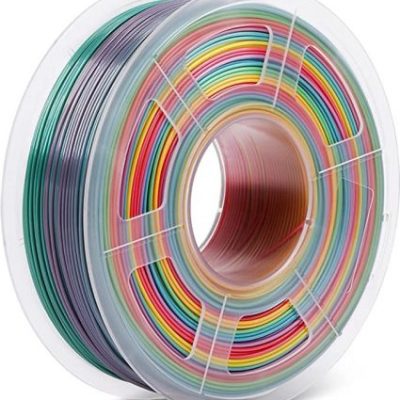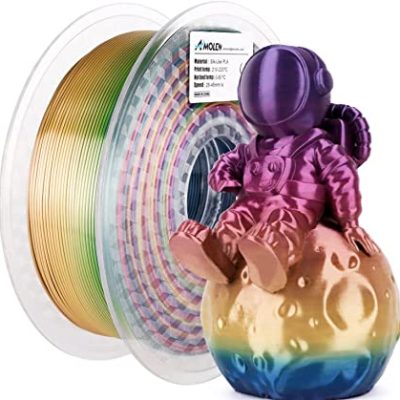- Last Updated: January 12, 2024
-
 Pat Nathaniel
Pat Nathaniel
 Variety is the spice of life.
Variety is the spice of life.
This has never been truer for 3D printing projects. Monochrome printers have always been the norm for 3D printers, but the need for diversity is creeping into the 3D printing space.
What does this mean for you?
Settling on a multicolored rainbow PLA filament is a daunting task with several considerations mainly:
- How the filament handles stress, moisture, and nozzle temperatures?
Suppose you are wondering how rainbow PLA will affect your printing. In that case, you should know that it has similar specifications and requirements to regular PLA filament, with the bonus of having a spectrum of colors at your disposal.
However, the distance from one color to the next is not standard, which makes the color scheme in the finished project more about chance than planning.
Our favorite rainbow filaments are Sunlu rainbow filament which offers the best value for your money, providing customers with an unrivaled quality-to-price ratio. Amolen rainbow silk PLA filament, on the other hand, offers you premium quality, albeit at a slightly higher cost. For the best print quality, eSUN silk PLA 3D filament remains the best choice.
Read below to find out more!
Best Rainbow Filament At A Glance
Sunlu filaments are familiar to the market, and neither are the Sunlu rainbow filaments. If the value for your money is your driving force when settling for a printing filament, then Sunlu rainbow filaments are what you need. Boasting the best quality-price ratio in the industry, Sunlu PLA filaments come in eye-catching colors.
Green, red, purple, pink, and blue; all the primary colors are covered in true Sunlu style. A downside, however, is that the first color to leave your nozzle is random.
In addition to its value advantage, the Sunlu rainbow filament has several other advantages. It is compatible with many standard 3D printer models, delightfully sticks to the bed, and offers uniform feeding without the risk of clogging the nozzle or extruder.
Sunlu rainbow filaments come straight off the production line with a guaranteed diameter tolerance of 0.02mm, and a filament diameter of 1.75mm. The filament prints at a speed of 50-100mm/s, keeping it abreast with its competitors. It also has a printing nozzle temperature of 190-230°C and a bed temperature of 80°C.
If you are a beginner seeking the colorful and shiny appearance of multicolor filaments without the hassle of dual extruders, look no further than Sunlu Rainbow PLA filaments.
Pros
- It is the most affordable rainbow PLA filament on the market
- It features a unique and functional packaging style
- Best quality-price ratio
- Color changes after 15-18 meters
Cons
- With such high printing temperatures comes the risk of inhaling uncomfortable fumes.
Amolen has been offering the world of 3D printing high-quality products for a while now, gracing customers with favorites such as glow-in-the-dark filaments. Their silk PLA filaments are nothing short of pleasing, both in functionality and appearance.
From their silky smooth texture to the lustrous and colorful finish, Amolen‘s rainbow silk PLA filament is a premium choice.
With a filament diameter of 1.75mm, high diameter tolerance, and reliable dimensional accuracy of 0.03mm, Amolen filaments are perfectly compatible with most of the FDM 3D printers on the market and in your home. You need not worry about bubbles or jamming as the company provides customers with a guarantee of premium quality filaments.
Amolen provides plenty of after-sale services and support to its clients, with round-the-clock customer support and a 100% satisfaction guarantee. In terms of packaging, the Amolen rainbow silk filaments feature a desiccant to keep the filament moisture and dust free. Amolen filaments have a nozzle temperature of 190-220°C and a bed temperature of 0-50°C.
If you are looking for a rainbow filament for a small project, Amolen is the best option, as it has color changing length of just 15 meters. It is also perfect where glossy finishes are preferred.
Pros
- Excellent customer support
- Premium quality rainbow PLA filaments
- Silky texture and shiny appearance
- Color changes after about 15 meters
Cons
- Slightly more expensive than other rainbow PLA options
eSun is a small business making significant strides in the rainbow filament space. eSun’s rainbow filaments fall under their line of aesthetic PLAs. Far from the norm, eSun specializes in cooler colors. Their color range, therefore, is not as broad as would be expected of a rainbow filament. The eSun catalog features blue and green colors with cool brown hues that blend with the primary colors.
The effect of blending vibrant blue and green colors is that the finished product acquires an appealing luminous appearance.
The luminescent eSUN 3D rainbow filament has attractive features, such as a diameter of 1.75mm, which is the standard for the range. It has a dimensional accuracy of 0.03mm and a recommended printing nozzle temperature of 190-220°C.
A downside of eSun’s brilliant rainbow PLA is that they are more abrasive and, therefore, more likely to clog typical nozzles and extruders. For this reason, those looking for the opportunity to utilize eSun’s rainbow filaments use hardened steel or ruby nozzles to withstand the abrasive silk PLA 3D filament.
Check our related article on the best silk filaments if you like shiny and super silky prints.
Pros
- Silky smooth finish
- Luminous appearance
- Cooler color options are available
- Print speed of 40-100mm/s
Cons
- The filament can clog nozzles and extruders
- Limited color ranges
TTYT 3D filaments are your to-go when functionality and visual appeal are at the top of your requirement list. An obvious advantage of the TTYT rainbow filament is its fast color change features. As the end user, this means that you can comfortably use the TTYT 3D rainbow filament for smaller projects.
The TTYT 3D rainbow filament has a silky texture and glossy appearance. In addition, the filament offers customers the ease of avoiding edge warping, clogging, and indoor printings. Yes, you can use the TTYT 3D printer in your home without worrying about toxic fumes.
With a gradual color change length of 3-5 meters, you can see the full spectrum of colors in your project without waiting for the standard 15 meters.
The TTYT filament has a diameter of 1.75mm and a dimensional accuracy of 0.03mm. The recommended printing temperature for the TTYT rainbow filament is 220°C and a hotbed temperature of 50-60°c.
In addition to the rainbow filament, TTYT sends you home with some handy gifts, including nozzle cleaning needles and a vacuum package with a zipper bag.
The TTYT 3D rainbow filament is ideal for smaller projects and people looking for quicker multicolor transitions for their 3D printer. It is also a big hit with 3D printer fanatics that lack the outdoor space for separate printing since it is indoor-friendly.
Pros
- Faster color changing
- Indoor printing capabilities
- Silky-glossy finish
- Print speed of 40-80mm/s
Cons
- The total color length is smaller than average.
MIKA3D multicolored filaments come in many warm and cool colors. Regardless of your printing needs, there is something for everyone. Each color option comes in a silky appearance giving your 3D printing projects that highly sought-after glossy appearance.
MIKA3D offers color options ranging from blue, yellow, purple, orange, and red, each having a shiny, lustrous appearance.
MIKA3D filaments are engineered for compatibility with most FDM 3D printers popular in the 3D printing world. The company presents the multicolored filament as having guaranteed no-bubble, no-jamming, and no-warping features when packaged.
With additional company tips, you can also ensure that you experience a clog-free process when using the filament on your printer.
For the perfect multicolored filament experience, MIKA3D recommends using a 0.4mm nozzle. Customers advise you to use a printing nozzle temperature of 150-220°C and a bed temperature of 60°C for the best results.
MIKA3D ships its multicolored filaments with several other gifts, such as one bottle of premium 3D printer tool used on the heat bed.
The MIKA3D filament is an easy-to-use rainbow filament ideal for 3D printing enthusiasts looking for a multicolored filament that changes color faster than the average gradual color change for more colorful or smaller projects. MIKA multi-colored filaments randomly change color after 5-10 meters.
Pros
- Silky and shiny appearance
- Smooth glossy texture
- Fast color changes
- Print speed of 50-90mm/s
Cons
- Some users find it extremely moisture sensitive
- Strict specifications for optimum user experience
Flashforge has been at the forefront of polylactic acid use for 3D printing for some time now. Over time, they have garnered unrivaled expertise in 3D printing, and the Flashforge rainbow filament is the perfect platform for the company to show its skill. PLA filaments by Flashforge are eco-friendly and have a minimal shrinking and warping probability.
Flashforge rainbow filaments come in many colors, including green, red, orange, yellow, and blue. Unlike many of the rainbow PLA filaments available in the market, Flashforge multicolor PLA gradually changes color after 30-40 meters. If you have been paying attention, you know that such a large number translates to waiting longer for the color transitions.
Flashforge rainbow filament, therefore, only becomes practical for large projects. Otherwise, you might end up with a monochrome finish. Flashforge rainbow filaments have an external diameter of 1.75mm and a dimensional accuracy of about 99 percent. Flashforge filaments are strictly restricted to 0.02mm in terms of diameter probability.
Flashforge guarantees customers that their filaments are clogged and tangle-free. In addition to this, the filaments are also bubble-free. They are packaged 24 hours after drying in a vacuum-sealed and desiccated environment to ensure no clogging and the filament feeds smoothly.
Flashforge rainbow filaments are perfect for quick projects such as making prototypes, jewelry, toys, concept statues, and many more low-cost projects. Furthermore, it is perfect for projects that tolerate the significant color change gap.
Pros
- The significant gradual change in color
- Eco-friendly design
- Guaranteed return policy
- Lifetime customer support
- Printing speed 40-60mm/s
Cons
- The delayed color change is not ideal for small projects
- Relatively expensive
A fine metallic finish is required for a project meant to please the eye. Artwork, for example, requires a delicate and lustrous finish, and for many printers, the best way to achieve this is by polishing the final product.
With CC3D silk rainbow multicolor PLA, however, you can do without the strenuous work of polishing.
The CC3D silk rainbow multicolor PLA is an excellent choice when selecting a high-detail filament for your printing project. It has an outstanding authentic metal finish and is compatible with many printers in use for domestic and industrial purposes. You do not need a specialized nozzle as the filament is non-abrasive.
For the best printing experience, the company advises customers to follow the following parameters when the filter is in use:
- A printing speed of 20-25mm/s for the first layer and 25mm/s for subsequent layers
- Printing nozzle temperature of 210-220°C
- Hot bed temperature of 40-60°C
- Retraction speed <45mm/s
The CC3D silk rainbow filament is the perfect companion for 3D printers looking for a delicate, polished, metallic appearance for their finished project. Ideally, this rainbow filament is best for artwork and similar visually appealing projects.
Pros
- The pleasing, polished, and metallic appearance
- Clog and tangle free
- Bubble free
- Relative moisture tolerance
- Customer support available
Cons
- Limited color choices
- Some users find the filament challenging to work with at first
What Is a Multi-colored Filament?

Multicolored filaments, sometimes referred to as rainbow filaments, are 3D printing filaments with different colors loaded onto the same filament and spool. Multicolor filaments come in various color options, some of which are bicolor, tricolor, or rainbow filaments, offering more than four colors.
The rainbow filament’s colors are usually set in a factory-determined gap to print a project with multiple colors. The more significant the gap, the longer it takes for a specific color to be expressed in the project. Most multicolored filaments operate under the exact specification of other 3D PLA filaments and are thus compatible with many printers.
If you want to learn more about multicolor 3D printing and multicolor 3D printers read our article here.
How Do You Print Rainbow Filaments?

As mentioned earlier, anyone with experience with PLA filaments has the appropriate know-how to print rainbow filaments. Each rainbow filament, however, has specific manufacturer requirements and must be approached with an open mind for the best results.
Meddling with new filaments is always tricky, but you may follow the following guidelines to ensure you stand a good chance of printing out a masterpiece:
1. Clean Your Nozzles and Extruders
Before putting in a new filament or completing a filament project, your nozzle is most vulnerable. Should residue filament exist, your next project may not go as smoothly as the last. The residue on the nozzle and extruder often causes clogging as it interrupts the regular feeding of the filament.
2. Keep Your Filament Moisture free
Suppose you have encountered some irritating pop sounds while printing with any filament. In that case, your 3D printer probably warns you that the filament has been infiltrated by moisture and needs to dry. Read our article on the best filament dryers here for more info.
3. Stick to Manufacturer Specifications
Most 3D printing manufacturers have researched their rainbow PLA filaments extensively and found appropriate specification ranges within which the filaments can operate. Customers are advised to stick to these specifications to avoid clogging and jamming.
What To Expect From Multicolored Filaments

Multicolored filaments are pretty straightforward, as the name suggests. They come in various colors and allow printers to obtain multiple colors for their projects without changing the filaments. Some filaments offer better anti-clogging properties than others, but for the most part, rainbow filaments are very reliable.
Is a Rainbow Filament Abrasive?

Various rainbow filaments are available, with uneven textures and compositions. For example, the luminescent eSUN silk PLA filament is an abrasive variant of rainbow PLA filaments and therefore requires hardened steel nozzles and ruby extruders. Non-abrasive variants, on the other hand, do not need specialized nozzles.
Factors To Consider Before Buying a Rainbow Filament

When looking for a rainbow filament for your 3D printing project, there are several factors to consider, which all depend on the nature of your project. Some filaments are ideal for smaller projects, while others are for larger projects. Whichever the case, you should consider the following when purchasing a rainbow filament:
- Color change length
- Cost for purchase
- Nozzle printing temperatures
- Hot bed temperature
- Print speed
- Retraction speed
- Color range
- Finished appearance
- Moisture tolerance
- Filament length
- Filament material
Advantages and Disadvantages of a Rainbow Filament

There are several obvious advantages of rainbow filaments over their monochrome counterparts, but they also have some drawbacks.
The advantages include the following:
- Colorful Appearance
- Ideal for beginners
- PLA filaments do not require a heating bed
The disadvantages include the following:
- Gradual and delayed color changes
- Some rainbow filaments are abrasive
- The length of colors may be random and insufficient
- The colors of the finished product are entirely by chance
Conclusion
Rainbow filaments are perfect when looking to add a bit of spice to your 3D printing projects. Rainbow PLA filaments make your 3D prints more attractive, and some might make them smooth and glossy. However, depending on your printing requirements, the title of the best rainbow filament varies considerably.
Sunlu rainbow filament offers the best value for your money, providing customers with an unrivaled quality-to-price ratio. Amolen rainbow silk PLA filament, on the other hand, offers you premium quality, albeit at a slightly higher cost. For the best print quality, eSUN silk PLA 3D filament remains the best choice.
Related Articles:















